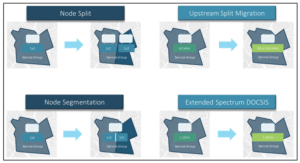



What Tactical Needs Are Driving DAA Deployments?
Much of the capacity challenge that cable operators face is related to limits in the access network and centers around the fiber nodes. Operators are continuously evaluating the utilization level of their nodes and whether they are providing the level of service customers expect. If a node is falling short, there are several methods of increasing performance in that part of the network (See Figure 2):
1. Physical node splits –adding a second fiber node and splitting the households served by the original node across two nodes. If a node is segmentable, rather than adding a second node, the households served by the node can be spread across two service groups.
2. If the challenge is the upstream capacity, an operator will also consider changing the upstream split, moving from a low split (42MHz) or European split (65MHz) to a mid-split (85 MHz) or even a high split (204 MHZ).
3. In the longer term, cable operators will expand the overall spectrum available from the 1.2 GHz in DOCSIS 3.1 to 1.8 GHz in DOCSIS 4.0.

Figure 2: Methods of alleviating network saturation
How do these plans drive a move to DAA?
These types of changes to fiber nodes also usually require changes to other equipment in the access network, including more lasers and CCAP ports in the hub. These, in turn, take up more hub space, consume more power, and increase ongoing plant maintenance. The operator may even need to install additional fiber.
DAA eliminates the need to add equipment in the hub. In fact, DAA reduces the amount of equipment and power required in the hub, enabling hub consolidation and hub collapses. Furthermore, it eliminates much of the outside plant maintenance by digitizing the link between the hub and the node. As a result, the analog signals are generated and received in the node at the very point where the coaxial cable starts, improving signal quality for the customer.
This improved signal quality also allows cable operators to further increase the capacity of their access network by letting them take advantage of the full capability of DOCSIS 3.1. One major cable operator’s internal study showed that the improved signal quality of DAA would increase their network capacity by 20%.
The bottom line is that if an MSO is going to touch their nodes, no matter whether that is for a node segmentation or upstream split migration, it makes sense for them to make the move to DAA. DAA enables more capacity with less space and power and fewer service calls.
Furthermore, moving to DAA pushes fiber and Ethernet deeper into their network, in fact, into the neighborhood, and sets the network up: 1) to support other revenue-generating opportunities such as mobile backhaul and PON-based business services, 2) for network virtualization and automation and 3) to migration to FTTH.
This blog is the 2nd in a series of blogs from Vecima Networks looking at the most asked questions we get regarding DAA and FTTH. The first blog can be found here It discusses “What is the state of DAA standardization and interoperability for R-PHY, R-MACPHY, and Flexible MAC Architecture (FMA)?”
Blog #3 is “What are some of the key decision criteria when deciding between Remote PHY and Remote MACPHY?” and can be found here.
Get Started with Vecima
We help our customers evolve their networks with cloud-based solutions that deliver ground-breaking speed, superior video quality, and exciting new services to their subscribers.
Contact Us

